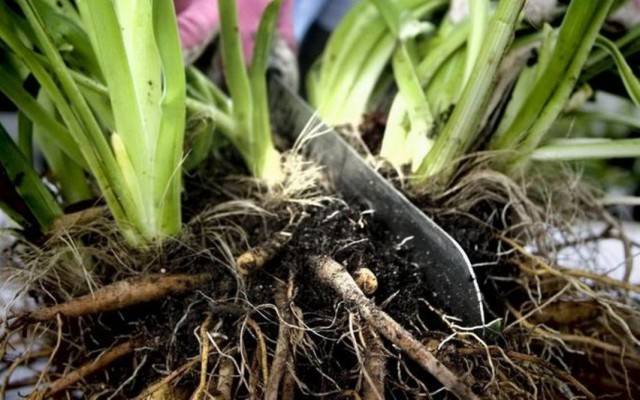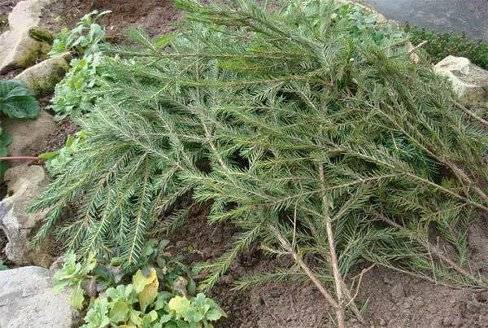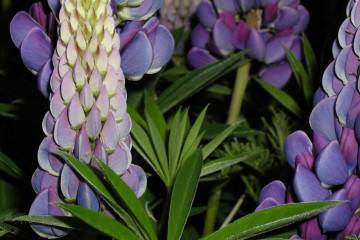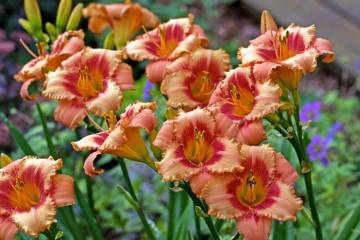When to transplant daylilies - how to do it right
Content:
Daylilies have another name of Greek origin - Hemerocallis, in Russian it sounds like krasodnev. In most species of daylily, each (and very beautiful) flower on the arrow of the plant blooms (flaunts) one day.
There is a belief about the magical power of the daylily. You need to get up at dawn and touch the flower, then all the bitterness will be forgotten, and the sorrows will go away.
Up to 3 flowers bloom at the same time. The total flowering time of the bush is up to 30 days. After that, you can transplant the bushes.
Why transplant
Daylily is a perennial plant with cordlike fleshy roots that can form stolons. The plant is plastic, blooms even in the shade. But only in a sunny place, its beauty is fully revealed.
The bush can bloom in one place for about 15 years, increasing in size, but with age, the abundance and size of its flowers decrease. The roots, growing, intertwine with each other, and the plant begins to feel a lack of nutrition.
Experts recommend replanting the bushes after 5-7 years to prevent degradation of the bush. The appearance of flowering shoots near the mother bush will serve as a reminder.
If you neglect this operation, then even support with fertilizers will not help, the beauty of the bush begins to fade. And then the gardener will be faced with the question: when to transplant daylilies?
Transplanting daylilies is possible at any period of its growing season: from early spring to late autumn. The survival rate of a plant depends on the conditions of caring for it and the growing climate. Preference is given to a spring transplant, in which the delenki easily take root and bloom in the same year.
Site selection and preparation
For planting the daylily, choose a place that is illuminated by the sun for at least 6 hours. The darker the color of the flower petals, the more shadow is allowed when choosing a planting site. In bright sunlight, dark-colored flowers fade.
The soil is cultivated to a depth of 30 cm, picking out the roots of the weeds. Heavy soil is lightened with sand, sandy soil is enriched with compost or peat. The hole should be twice the size of the rhizome.
Even an inexperienced gardener can cope with transplanting and dividing a perennial:
- The dug out bush is cleared of soil.
- Cut off diseased or damaged roots.
- Divide into parts with a sharp shovel, pruning shears, hands if possible.
- Delenki are soaked in a fungicide solution, then in a rooting stimulator.
To free the roots from the ground, you need to rinse them under the tap or hold the dug out bush in a container of water.
Fertilizers are applied to the planting hole, preferably organic, during the month the seedling is regularly watered.
It is advisable to keep the planting level the same as at the previous place of growth. A white stripe at the base of the stems will tell you about it. The root collar is buried 2-3 cm.
The distance between the bushes during planting is 80-100 cm.Daylily grows quickly and well in breadth.
Features of seasonal transplant
When can daylilies be divided and planted? The answer is very simple: when the need arises.
Daylilies tolerate transplanting at any time of the year, except for snowy and frosty winters.
Transplant in the fall
When transplanting a daylily in autumn, it is important to choose the right timing, since:
- the bush needs time to take root before frost;
- Planting too early will prevent the plant from recovering from flowering and storing nutrients.
The advantage of an autumn transplant is the ability to choose the right plants. In the fall, flower buds appear on the bush, they are clearly visible and during transplantation it is easy to avoid damage to them.
The updated daylily will bloom for the next season.
Nuances of summer transplant
Before you transplant the daylily in the summer, you need to remember some rules that will help the bush to survive the "move" comfortably.
Summer transplanting has almost no effect on the well-being of the bush. At the same time, you must try not to disturb the root system of the plant, pulling it out with a clod of earth. You should confine yourself to simple pruning of rotten roots and sprinkle the cuts with ash. It is not recommended to divide the bush in the summer.
At high air temperatures, it is better not to touch the daylily. The transplant is carried out in cloudy weather or in the evening.
Spring transplant of bushes
The advantage of a spring transplant is that delenki with a developed root system begin to bloom in the same year, and their survival rate is high. An undeveloped root system will allow the bush to bloom only next year.
When asked about the timing of the daylily transplant, when it is better to do this, preference is given to spring work. Their plus is that the seedling has a lot of time in stock for settling in a new place.
The division of the bushes is carried out with sufficient heating of the soil, this is the end of April - the beginning of May. The shovel should go into the ground with a bayonet to easily dig out the rhizome of the entire bush. After inspection, the rhizome is divided into parts, slightly shortening healthy roots and cutting out rotten ones. The resulting seedlings can be stored for up to a month before planting.
Transplanting a flowering daylily
When the daylily is in bloom, it can be transplanted. When transplanting, a flowering plant will get stress anyway. To alleviate its condition, the daylily should be watered abundantly, and then dug out with a large clod of earth, in no case dividing it into divisions. In a new plot, the bush is covered, for example, with lutrasil for 2 weeks, and the soil moisture is maintained.
For guaranteed rooting, you will have to sacrifice stems and peduncles. They take a lot of strength from the bush, leaving no vital energy for rooting. The stems are cut, departing from the root collar by 15 cm.
The appearance of young leaves means that the plant has taken root in a new place.
When and how to transplant a daylily depends on the climatic factor, the need for the procedure and the wishes of the gardener.
Post-transplant care
Competent care of a perennial will provide it with the ability to long and lush flowering.
Watering
Immediately after transplanting, the soil under the bush is abundantly watered and mulched to retain moisture. For mulch, use rotted needles or crushed bark. The covered soil does not overheat in the heat, it is easy to keep it loose.
The powerful root system of the perennial allows it to survive the absence of watering for a long time, but the number of buds and the size of flowers will decrease. With a lack of moisture, even the foliage turns pale.
Watering infrequently, but abundantly. In the heat, it is better to water (sprinkle) through a fine sieve of a watering can.
Top dressing
During transplantation, fertilizers are applied to the hole, therefore, the daylily does not need feeding in the first year. They begin to carry out it from the second year and bring it in dry or liquid form three times per season:
- in early spring - with complex mineral fertilizer;
- when buds appear - complex fertilizer;
- after mass flowering - phosphorus-potassium fertilizer.
The culture loves liquid organic fertilizing in light concentration. They are held from June to August.
Pruning
In the spring, for rejuvenation, cut off old leaves along the edge of the bush, dried stems.
After flowering, the peduncles should be cut out.
In late autumn, the old leaves are cut off, leaving only the young, recently regrown ones. Trimming is optional. Dried leaves will additionally protect the perennial from the winter cold.
Preparation for wintering
The roots of many varieties of daylily tolerate frosts down to -25 ° C. The upper part of the plant freezes out after the first frost.
Mulching with dry peat or sawdust will help the bushes to winter safely. This should be done after the cold weather sets in.
Heat-loving varieties require additional cover with spruce branches.
In landscape design, daylilies are used in single or group compositions. Their fate depends on proper planting and care: whether they will become a decoration of the garden or will vegetate. And an important role in this is played by the transplant, which must be carried out according to the rules described above.




















